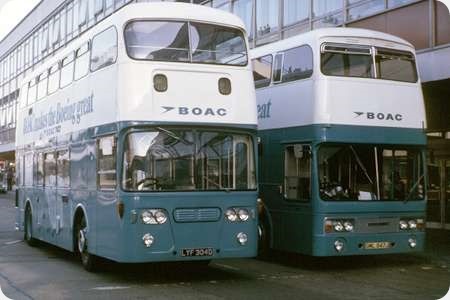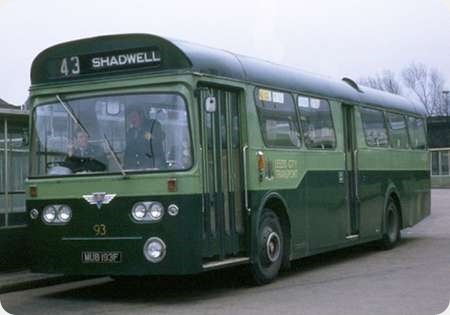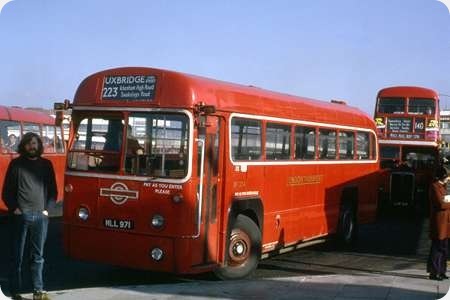
British Overseas Airways Corporation
1966
Leyland Atlantean PDR1/1
MCW CH38/16F
In 1940, with Britain at war and civilian air traffic barely existent, Croydon based Imperial Airways
formally subsumed the privately owned (though nationally subsidised) British Airways at Heston and
became BOAC, though this had been the de facto situation since September 1939. At the end of the war,
with Heathrow becoming the major UK airport, the European air passenger traffic business was separated
from BOAC in 1946 and named BEA. (British South American Airways, a short lived separate company formed
at the same time for the South American air services, was reabsorbed into BOAC in 1949 after the
disappearance of two Avro Tudor aircraft over the Atlantic.) To fulfil the road transport requirements
between London and the developing Heathrow Airport, the Ministry of Supply allocated BEA and BOAC a
number of Commer Q4 Commando 1½ deck observation coaches with Park Royal 20 seat bodywork that had 180
cubic ft of luggage space under the raised rear section. BOAC, operating from the former Imperial
Airways building at Victoria, stayed with Commer for its replacement passenger road fleet and took
Harrington bodied examples of the early petrol engined Avenger model between 1949 and 1952, though a
solitary Harrington C37C bodied Leyland Royal Tiger PSU1/13 came in 1950. The TS3 two stroke powered
Harrington Contender then became the favoured choice, and BOAC became the Contender’s best customer
taking a total of 28, of which 19 were employed in overseas locations. (Strangely, the Harrington
Contender does not appear at all on BLOTW.) The last BOAC Contenders (the figure varies between one and
three) reputedly had the Rolls Royce petrol engine (again, sources vary as to whether this was the
straight eight B80 or the six cylinder B60) married to a torque converter, a power train concept surely
inspired by a variant of the Dennis fire engine. One wonders, however, how this layout could have been
accommodated like the flat TS3 engine under the floor of the Contender.
As air travel became more popular, both BEA and BOAC turned to the double decker for the airport links.
BEA, whose road operations were overseen by London Transport, took the Routemaster, but BOAC preferred
the Leyland Atlantean PDR1/1, purchasing fifteen in 1966, LYF 304D to LYF 318D inclusive, with
“Alexander clone” MCW bodies that seated 38 passengers upstairs and 16 downstairs; the vacated space was
used for luggage. Later, in 1971, these were supplemented by six PDR2/1, GML 846J to GML 851J inclusive,
with Roe CH41/24F bodies. It is thought that all these Atlanteans were operated on behalf of BOAC by
Halls Bros. at Hounslow. The picture shows examples of each type at the Victoria terminal building.
PDR1/1 LYF 304D was delivered in October 1966, and PDR2/1 GML 847J arrived in July 1971. The BEA and
BOAC London - Heathrow road services were taken over by the new British Airways from 1974 and had ceased
by 1980, by which time air passengers had become accustomed to booking in directly at Heathrow, and the
central London passenger facilities had become superfluous. One of the MCW bodied vehicles, LYF 307D,
has been preserved.
Photograph and Copy contributed by Roger Cox
21/01/19 - 07:18
I remember riding in these Atlanteans out from Victoria to Heathrow. The BOAC
departure point was the ground floor of their headquarters, which faces Victoria coach station
across the road, although given the clientele of both BOAC and long distance coach at the time
probably very few transferred between the two.
There have been many memories posted on the
web about the buses out to Heathrow, a significant number of which seem to mix up BEA, BOAC and
British Airways, the separate London departure points (BEA moved round several time over the years),
and the vehicles, inevitably sometimes calling this BOAC fleet "Routemasters". After the
merger of the two airlines, although the two bus fleets were painted in a common livery, separate
operations were retained, from the different London points to the different Heathrow terminals the
two halves of the airline continued to use.
Did Halls actually run the BOAC fleet ? A poster
elsewhere on the web says they were employed by BOAC and drove them as part of their other airport
driving duties. The vehicle base was in airport property on the north side of Heathrow, where the
car parks are now. I saw the preserved Atlantean had been used in a nice British Airways TV ad with
a historic theme a few hears ago.
Halls did own another Atlantean fleet, Roe bodied, for US
airline TWA, likewise in their colours, used from their Piccadilly terminal, and also for other
independent hires, they could be seen at various points around London. Pan Am also had their own
road connections, with coaches, from a point in Kensington.
Bill
21/01/19 - 07:19
That was the last type of d/d bus I rode in at the start of my journey in May
1971 to Australia where I still reside.
David Revis
22/01/19 - 07:29
The operation of a bus fleet necessitates facilities for cleaning, washing,
fuelling and maintenance. It is possible, perhaps, that the driving staff were BOAC employees, but
did the airline really cover all the other essential requirements itself? It is surely more likely
that a specialist contractor like Halls would have been used.
Roger Cox
23/01/19 - 06:36
An airline at its main base typically has a very large fleet of motor vehicles
of all types, specialist and standard, and a Motor Transport maintenance department to suit. These
would operate both airside and on the road. I would imagine the BOAC motor fleet of all types
required at Heathrow would dwarf the Hall fleet, the numbers possibly into the hundreds, all of
which would require the services described. Further buses were commonly owned for passenger transfer
across the apron.
BOAC used to have some substantial articulated passenger trailers at
Heathrow pulled by HGV tractor units which shuttled between the terminal and the aircraft. They
lasted well into British Airways days. These were an interesting niche about which there is little
information.
Bill
23/01/19 - 06:37
I don’t see why BOAC who had a large fleet of lorries and other vehicles as
well as buses, would need a coach hire company to maintain their buses at Heathrow when they were
perfectly capable of looking after their own buses at Prestwick.
Stephen Allcroft
25/01/19 - 06:55
These services must have had a road service licence, probably the old Express
Licence, as they just charged fares, sold at a terminal counter, and anyone could go on them, not
just air passengers. 7 shillings and 6 pence (7/6) seems to ring a bell. I don’t recall there being
a published timetable (otherwise I would have taken one) but they were fairly turn up and go.
Both BOAC and successor British Airways also ran substantial fleets of regular coaches at Heathrow,
Leopards and others, run both airside and landside, for trips such as shuttles to hotels, and I
recall these coaches sometimes turned up on the BOAC Central London run as well. I presume the two
fleets were kept separate so those used only within the airport could run on red diesel.
Bill
28/01/19 - 07:29
These were certainly operated by BOAC as I worked in the PSV section of the
Metropolitan Traffic Area and, unusually, rather than use the post, on occasion a smartly uniformed
BOAC employee would turn up with a batch of renewal forms. I seem to recall that the vehicle
licences would have been stage, but I don’t doubt that the road service licences would have been
express.
I wonder if airside lorries and coaches would have run on red diesel within the
airport boundaries as ‘red diesel’ wasn’t available until later, and in any case, there was a
lot of domestic air traffic.’Red diesel’ is for agricultural use.
David Wragg
31/01/19 - 06:03
Red diesel is for use by anything that does not run on a public road. Boats,
trains, off-road industrial and construction vehicles and plant are allowed to use red diesel as
well as agricultural use.
Philip Halstead
31/01/19 - 11:49
Linking in with Philip’s comments, West Yorkshire used red Diesel when running
in overhauled engines on the two Heenan & Froude dynamometers in the engine test house at Central
Works. A small brick building behind the test house housed a largish fuel tank marked ‘gas oil’
specifically for the red Diesel. The units would probably have been classed as stationary engines
whilst on test.
Brendan Smith
04/03/19 - 06:30
Although I realise Roger’s posting is mainly regarding Leyland Atlanteans,
perhaps I may be permitted a few words of clarification regarding the Harrington Contenders used by
BOAC. Most of the Contenders were petrol powered using the Rootes "sloper" engine as
featured in the contemporary Avenger chassis. In fact a number of the BOAC Contenders were in
service two years before the TS3 diesel was announced. If the chassis codes are to be believed then
only 6 of the fleet were TS3 powered and all of these were exported - as were many of the petrol
versions. The petrol engines were front mounted but it seems likely that the TS3 versions were mid
mounted in the same way as the coaches that were available for general purchase. The Rolls Royce
Contenders were also mid-engine. Modifications were made to the intake system of the down draft
carburettors to reduce height and a fabricated sump was made to allow the engine to sit lower in the
frame. Two were built, both with B60 engines.
Nick Webster
05/03/19 - 06:51
Thanks for that clarification on the BOAC Contenders, Nick. Yours is the first
definitive explanation concerning these remarkable vehicles that I have encountered. One can
understand the preference for petrol engines in overseas locations, but why persist with them at
home? Again, do we know where the Rolls Royce powered coaches were based, and why such idiosyncratic
power trains were felt to be necessary? The expense of so adapting a mere two vehicles could not
possibly have been cost effective.
Roger Cox
06/03/19 - 15:33
I made an embarrassing error in my previous post - there were in fact three
B60 Rolls Royce Contenders for BOAC, not two as stated. They were JSD 851, KAG 783 and LCS 638,
delivered in 1956, 57 and 58 respectively. All went to Prestwick airport, at that time an important
hub in trans-Atlantic flight. There they stayed until individually returned to London during
1964-65. After a few months, LCS 638, the first to return was sent out for further use in Karachi.
It is known that at least one Commer based coach was also in use there but whether this replaced or
supplemented is not known. Never heard of again of course. The other two saw only months of service
(or perhaps just stored) before they were disposed via dealer Four Point Garages, Feltham to A. C.
Pond Coaches of Roydon. Both were scrapped before the end of three years. They were incidentally,
together with an unknown number of the Commers, six inches narrower than the standard 8 ft. coach. I
was fortunate enough to obtain drawings from Kirkstall axles, Leeds before they closed down.
In considering the logic of such vehicles, one has to remember that in the 1950s air travel was
promoted in rivalry to travel by Luxury Liner and the then necessary coach transfer was no time to
let the side down. Furthermore, although diesels reigned supreme in the service bus, many coach
operators for private hire insisted on smooth petrol vehicles even after rationing, rising prices
and supply problems resulting from the 1956 Suez crisis. For Harrington, even selling as they did to
the "top" end of the market, the reason for using a Rolls Royce engine is slightly more
prosaic: there was probably a sale on. In the mid 50s Rolls Royce were attempting to increase sales
their "B" range of engines and made them available to a wider market. For Harrington this
was a last determined attempt to make the various versions of the Contender attractive to all levels
of their customers. It is generally considered that Suez killed the Rolls Royce Contender. Indeed,
by 1958 the whole integral coach project was scrapped in favour of a new lightweight body later
known as the Crusader which was intended to suit the most popular chassis of the day.
Nick Webster
08/05/20 - 06:28
Just a little comment. Opposite the terminal was Victoria Coach Station, where
the Gay Hostess coaches operated. BOAC borrowed one for trials and that seemed to spur the idea. BEA
used LT Routemasters with a baggage trailer.
David
13/05/20 - 06:58
As this topic has resurfaced I have a question for Nick Webster, please.
I had long wondered what the difference was between the BOAC Contenders with T48B series unit
numbers and those with 48A. The T indicating the TS3 diesel engine makes perfect sense now.
It is well documented that Nick’s Contender JAP 698 has unit number 48A5018, which would imply it
was petrol-engine originally. A Harrington advert from 9/54 showing JAP 698 states with some
ambiguity that the Mk III version ‘now embodies the new Commer diesel engine’. So did JAP 698
briefly have a petrol engine or did Harrington perhaps swap in the diesel one when they were
erecting the running units?
Mr Anon
26/05/22 - 05:58
I joined the ‘new’ British Airways Motor Transport Division in 1976.
Part of our duties were to operate the Leyland Atlanteans Between Heathrow And B A’s Victoria
Terminal and return operations of course. The earlier Atlanteans had no power steering and were
moderately hard work but pleasurable to drive. Those of us with PSV all types and HGV class 1’s also
operated the Leyland Mastiff tractor units that pulled the passenger transfer trailers airside. (I
remember them as Mastiffs anyway). All seriously enjoyable. We had many vehicles including flight
deck crew cars and Leyland National single deckers also nice to drive but being rear engined, very
‘light’ on the front end and to be driven even more carefully in the wet.
E J Hunt



